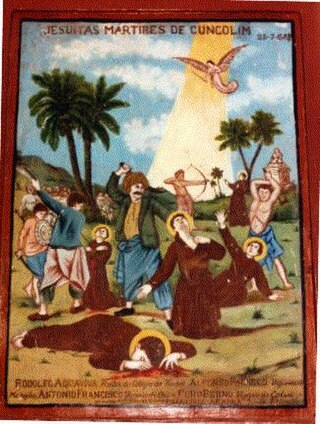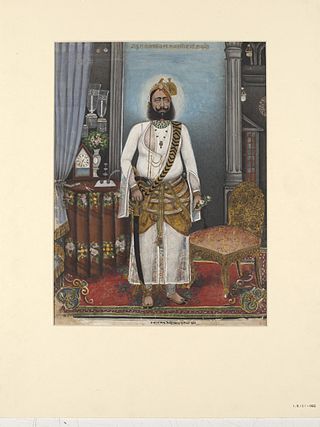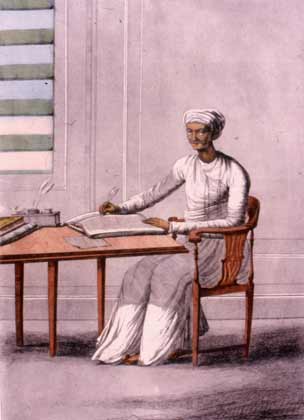Related Research Articles

Singh is a title, middle name or surname that means "lion" in various South Asian and Southeast Asian communities. Traditionally used by the Hindu Kshatriya community, it was later mandated in the late 17th century by Guru Gobind Singh for all male Sikhs as well, in part as a rejection of caste-based prejudice and to emulate Rajput naming conventions. As a surname or a middle name, it is now found throughout the world across communities and religious groups, becoming more of a generic, caste neutral, decorative name.
Rajput, also called Thakur, is a large multi-component cluster of castes, kin bodies, and local groups, sharing social status and ideology of genealogical descent originating from the Indian subcontinent. The term Rajput covers various patrilineal clans historically associated with warriorhood: several clans claim Rajput status, although not all claims are universally accepted. According to modern scholars, almost all Rajput clans originated from peasant or pastoral communities.

Khatri is a caste originating from the Punjab region of South Asia that is predominantly found in India, but also in Pakistan and Afghanistan. In the Indian subcontinent, they were mostly engaged in mercantilistic professions such as banking and trade. They were the dominant commercial and financial administration class of late-medieval India. Some in Punjab often belonged to hereditary agriculturalist land-holding lineages, while others were engaged in artisanal occupations and some were scribes learned in Sanskrit or Persian.
Reddy is a caste that originated in India, predominantly settled in Andhra Pradesh and Telangana. They are classified as a forward caste.

Patidar, formerly known as Kanbi, is an Indian landlord and agrarian caste and community mostly found in Gujarat but also in at least 22 other states of India. The community comprises at multiple subcastes, most prominently the Levas and Kadvas. They form one of the dominant castes in Gujarat. The title of Patidar originally conferred to the land owning aristocratic class of Gujarati Kanbis; however, it was later applied en masse to the entirety of the peasant population who lay claim to a land owning identity, partly as a result of land reforms during the British Raj.
Ahir or Aheer are a community of traditionally non-elite pastoralists in India, most members of which identify as being of the Indian Yadav community because they consider the two terms to be synonymous. The Ahirs are variously described as a caste, a clan, a community, a race and a tribe.
The caste system in Goa consists of various Jātis or sub-castes found among Hindus belonging to the four varnas, as well as those outside of them. A variation of the traditional Hindu caste system was also retained by the Goan Catholic community.

Charan is a caste in South Asia natively residing in the Rajasthan and Gujarat states of India, as well as the Sindh and Balochistan provinces of Pakistan. Historically, Charans have been engaged in diverse occupations like bards, poets, historians, pastoralists, agriculturalists and also administrators, jagirdars and warriors and some even as traders.

Roman Catholic Kshatriyas are a modern Christianised caste among Goan, Bombay East Indian, Mangalorean, Kudali & Karwari Catholics. They are the patrilineal descendants of Kshatriya and Vaishya Vani converts to the Latin Church, in parts of the Konkan region that were under Portuguese Goan rule. They are known as Chardo in Goan Konkani, Charodi in Canarese Konkani & as Sandori or Vadval in Damanese and Mahraashtrian Konknni, while others also identify as Bhandari or Khatri in the Bombay East Indian dialect. The well known households and well to do individuals among them, have mostly been endogamous.

Thakur is a historical feudal title of the Indian subcontinent. It is also used as a surname in the present day. The female variant of the title is Thakurani or Thakurain, and is also used to describe the wife of a Thakur.

The Koli is an Indian caste found in Rajasthan, Himachal Pradesh, Gujarat, Maharashtra, Uttar Pradesh, Haryana, Karnataka, Odisha and Jammu and Kashmir states in India. Koli is an agriculturist caste of Gujarat but in coastal areas they also work as fishermen along with agriculture. In the beginning of 20th century, the Koli caste was recognised as a denotified tribe under Criminal Tribes Act by the Indian Government because of their anti-social activities during World War I.
KHAM stands for Koli Kshatriya, Harijan, Adivasi and Muslim. Here Kshatriya is taken to include the Kolis. In the KHAM combine, Kolis were the largest caste represented at different levels of politics, and Madhavsinh Solanki increased the reservation quota for Other Backward Classes in Gujarat. The theory was propounded by Madhavsinh Solanki in 1980s in Gujarat to create vote bank for Indian National Congress and prepared by Jhinabhai Darji. Using the formula, Congress was able to capture 149 seats in the 182-member Assembly. However the formula alienated Patels permanently from Congress. during the Kham alliance, castes such as Bania, Patidar and Brahmins lost their importance in the state, so they propounded the Anti reservation agitation in 1981 and 1985 in Gujarat to get rid of the power of OBC castes.

Bengali Kayastha, is a Bengali Hindu caste originated from the Bengal region of Indian subcontinent, and is one of the main subgroups of the Kayastha community. The historical caste occupation of Kayasthas throughout India has been that of scribes, administrators, ministers and record-keepers; the Kayasthas in Bengal, along with Brahmins and Baidyas, are regarded among the three traditional higher castes that comprise the "upper layer of Hindu society." During the British Raj, the Bhadraloks of Bengal were drawn primarily, but not exclusively, from these three castes, who continue to maintain a collective hegemony in West Bengal.

Bhikhudan Govindbhai Gadhvi is an Indian folk singer and songwriter, known as a proponent of Dayro, a narrative singing tradition of Gujarat. He is a recipient of the Gujarat Gaurav Award of the Government of Gujarat and the Sangeet Natak Akademi Award. The Government of India awarded him the fourth highest civilian honour of the Padma Shri, in 2016, for his contributions to folk music.
Pingalshi Meghanand Gadhvi was a Gujarati folklorist, writer, singer and proponent of Charan literature from Saurashtra. Throughout his lengthy career, Gadhavi made significant contributions to the preservation and promotion of Gujarat's folklore and folk music as both a performer and scholar.

Bhāt is a "generic term" used to refer to a bard in India. The majority of Bhats hail from Rajasthan and worked as genealogists for their patrons, however, they are viewed as mythographers. In India, the inception of Rajputization was followed by the emanation of two groups of bards with a group of them serving the society's influential communities and the other serving the communities with lower ranking in the social hierarchy.

Aditya Gadhvi is a playback singer and lyricist hailing from Gujarat, India. He has rendered numerous chart-topping songs in various Indian languages. He is involved in Gujarati film scoring and has released a number of singles. Among his recent notable tracks are Khalasi, Rang Morla, the Gujarat Titans anthem Aava De, and several others.
Rawal is an Indian community from Rajasthan and Gujarat. They are known as priests of devi temples and perform a form of dance known as Rammat during the worship. They were well respected and patronised by the Charans.
Shambhudan Gadhvi is a former master clerk and amateur geologist from Gujarat who discovered the Indus valley site of Dholavira in the early 1960s.
References
- ↑ Avikunthak, Ashish (2022-02-03). Bureaucratic Archaeology: State, Science and Past in Postcolonial India. Cambridge University Press. ISBN 978-1-316-51239-5. Archived from the original on 2022-01-25. Retrieved 2022-03-26.
Gadhvi is an honorific title for a bardic caste of Gujarat called the Charans—a non-mendicant upper caste (not, however, Brahmins or Kshatriya) who have exerted considerable influence on the local polity since medieval times.
- ↑ Lal, R. B. (2003). Gujarat. Popular Prakashan. ISBN 978-81-7991-104-4. Archived from the original on 2022-01-02. Retrieved 2022-03-26.
The Charan are also called Gadhvi. As they were owners of Ghadh's (forts) in olden days, they are also known as Gadhvi.
- ↑ Meghani, Zaverchand Kalidas (2003). A Ruby Shattered: A Collection of Love-legends in Folk-balladry Form of Saurashtra. Bharatiya Vidya Bhavan. Archived from the original on 2022-01-12. Retrieved 2022-03-26.
GADHAVI: The governor of a fort (litt.). Charans were earlier known as Gadhavis.
- ↑ Tambs-Lyche, Harald (1996-12-31). Power, Profit, and Poetry: Traditional Society in Kathiawar, Western India. Manohar Publishers & Distributors. ISBN 978-81-7304-176-1. Archived from the original on 2022-02-10. Retrieved 2022-03-26.
Gadhavi is synonymous with Charan; it is also Mamodiya's surname, and a common one within the caste.
- ↑ Krishan, Dr Gopal; India.), M. Haque (Senior Technical Assistant, Anthropological Survey of; Mukherjee, A. (1994). Morphogenetic Variation: A Comparative Profile of Three Tribes of Gujarat. Anthropological Survey of India. ISBN 978-81-85579-13-9. Archived from the original on 2022-03-26. Retrieved 2022-03-26.
It is also said that the title 'Gadvi' is applied to Charans because they were often the owner of 'Gadhas' (forts).
{{cite book}}: CS1 maint: multiple names: authors list (link) - ↑ Prāci-jyotī; Digest of Indological Studies. 1990. p. 70. Archived from the original on 2022-03-26. Retrieved 2022-03-26.